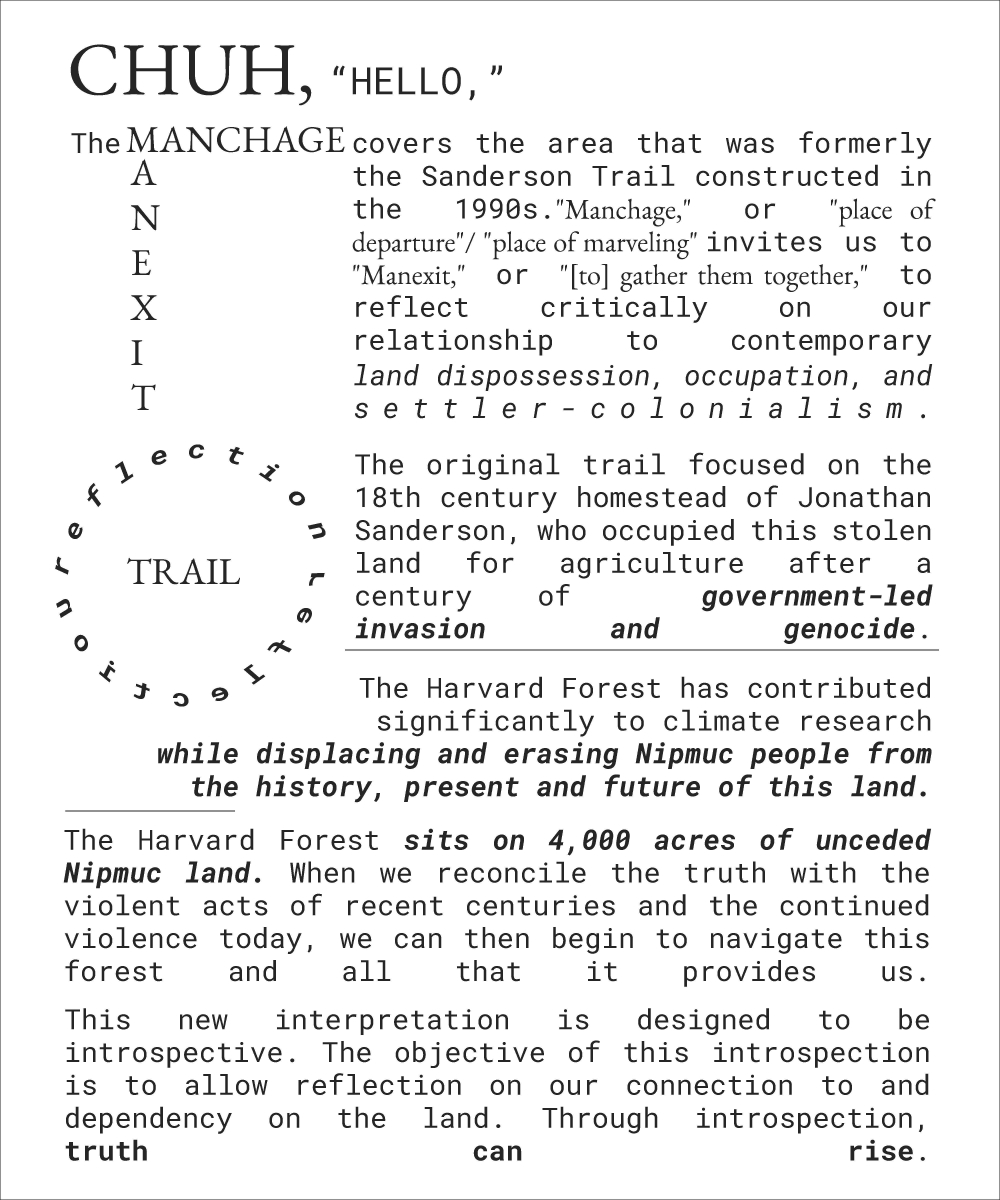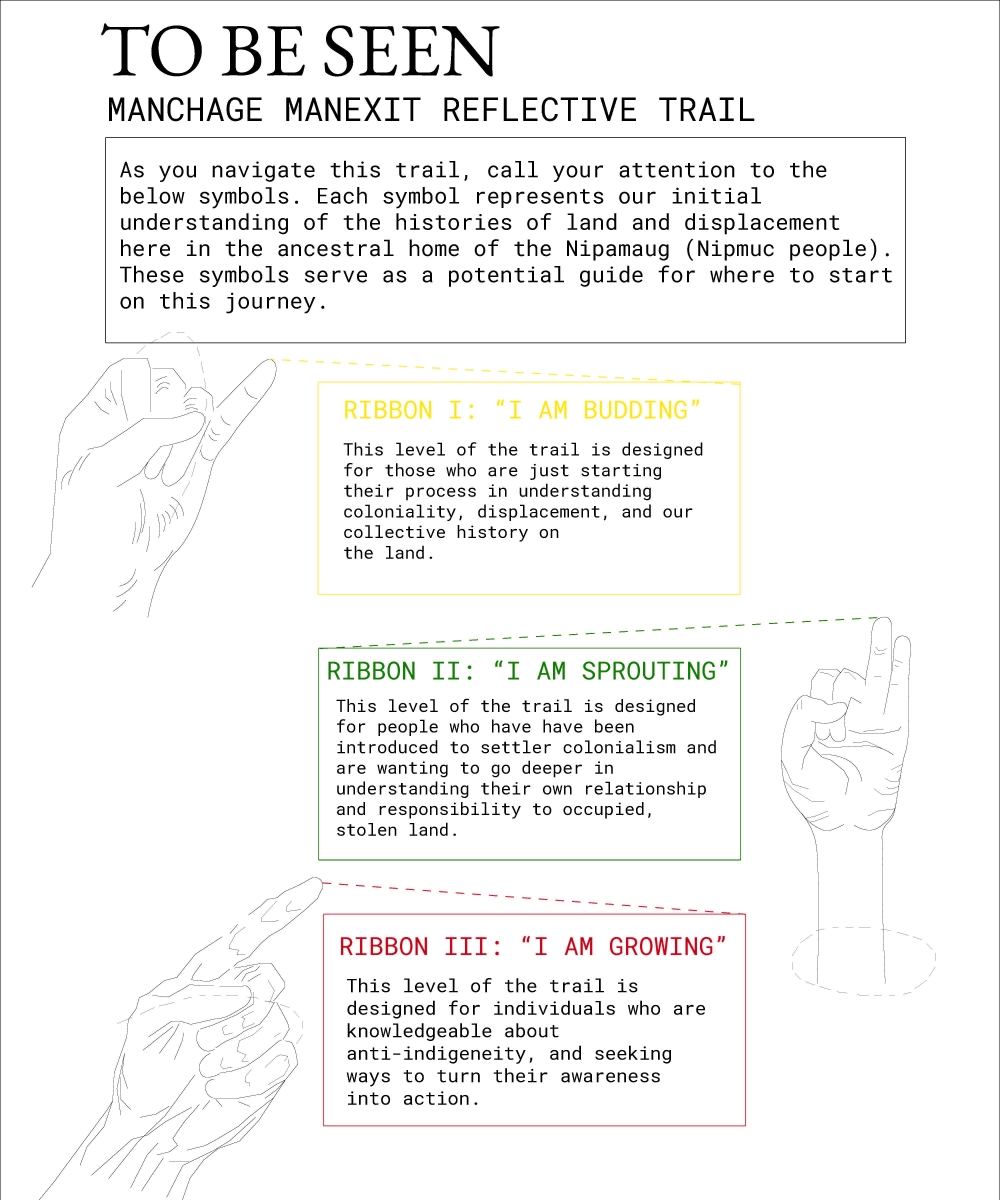You are here
Manchage Manexit: Trail Introduction
The trail is introduced with three panels collectively situated in the grass that precedes the woods at the southwestern corner of the trail, just southeast of the main buildings. A fourth introductory panel is situated several yards away, next to a small stream.
Click the images on this page for a larger version of each sign.
The first introductory sign, to the left, creatively shows the title of the trail, "MANCHAGE MANEXIT TRAIL," with the word reflection curving and mirroring around the silhouette of a tree. At the bottom of the first sign reads the following text:
Funded by: Harvard Culture Lab Innovation Fund
Sign Design: Tyler White
Research Associates: Kashish Bastola and Tyler White
Research Supervision: Nia Holley
Grant leaders: Clarisse Hart and Shersingh Joseph Tumber-Dávila
The second introductory sign, below, has the following text:
CHUH, "HELLO,"
The Manchage Manexit Reflection Trail covers the area that was formerly the Sanderson Trail constructed in the 1990s. "Manchage," or "place of departure" / "place of marveling" invites us to "Manexit," or "[to] gather them together," to reflect critically on our relationship to contemporary land dispossession, occupation, and settler colonialism.
The original trail focused on the 18th century homestead of Jonathan Sanderson, who occupied this stolen land for agriculture after a century of government-led invasion and genocide.
The Harvard Forest has contributed significantly to climate research while displacing and erasing Nipmuc people from the history, present and future of this land.
The Harvard Forest sits on 4,000 acres of unceded Nipmuc land. When we reconcile the truth with the violent acts of recent centuries and the continued violence today, we can then begin to navigate this forest and all that it provides us.
This new interpretation is designed to be introspective. The objective of this introspection is to allow reflection on our connection to and dependency on the land. Through introspection, truth can rise.
The third introductory panel, below, introduces three symbols that are used throughout signs to share three levels of understanding and introspection. The sign has the following text:
TO BE SEEN
MANCHAGE MANEXIT REFLECTIVE TRAIL
As you navigate this trail, call your attention to the below symbols. Each symbol represents our initial understanding of the histories of land and displacement here in the ancestral home of the Nipamaug (Nipmuc people). These symbols serve as a potential guide for where to start on this journey.
RIBBON I: "I AM BUDDING"
This level of the trail is designed for those who are just starting their process in understanding coloniality, displacement, and our collective history on the land.
[The symbol shown is a hand closed with the pinky finger outstretched.]
RIBBON II: "I AM SPROUTING"
This level of the trail is designed for people who have been introduced to settler colonialism and are wanting to go deeper in understanding their own relationship and responsibility to occupied, stolen land.
[The symbol shown is a hand with the two smallest fingers pointing upward and the thumb closed over the pointer and index fingers.]
RIBBON III: "I AM GROWING"
This level of the trail is designed for individuals who are knowledgeable about anti-indigeneity, and seeking ways to turn their awareness into action.
[The symbol shown is a hand with all fingers closed except the index finger, which points assertively upward.]
The fourth introductory sign (shown to the right) is located at the edge of the woods, adjacent to a stream. In addition to an image showing three trees and several thin, winding lines throughout, the sign includes the following text (in this order):
Ask yourself before you start
1 What are my intentions?
3 What will I take away?
2 What will I offer?
Wame quoshahtaush
"Everything is ready"





